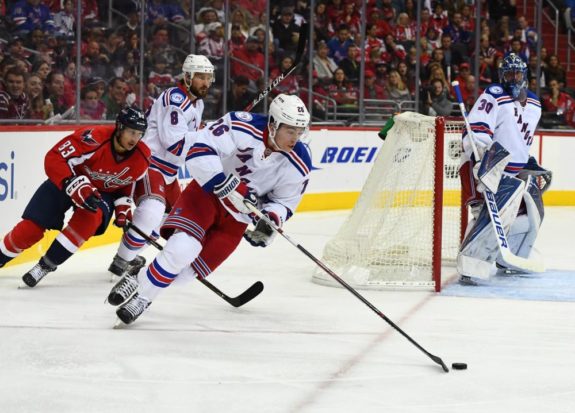When it comes to rookies, there’s always going to be surprises. Some exceed all expectations, while others are a disappointment. When it comes to getting the most out of rookies, each NHL team approaches development differently. While some coaches play their rookies every night, others ease them into the league.
Which way is the best way, though? The answer is not a matter of opinion, but rather of physical fitness and fortitude. One player may benefit from more days of rest in-between games, while another may perform better when he’s played every night.

Pavel Buchnevich of the New York Rangers played in five of the Rangers’ nine games in October. Joel Eriksson Ek of the Minnesota Wild played in six of their 10 games and Jesse Puljujarvi of the Edmonton Oilers has played in eight of their 10 games.
This is one of the differences found in rookie development: the amount of time a rookie spends on the ice. Some get more ice time, more shifts and longer ones too. Out of all 2016-17 rookies, Ivan Provorov of the Philadelphia Flyers has received the most ice time and Nikita Zaitsev of the Maple Leafs has seen the second most amount of time on ice (TOI).
What everyone really cares about, though, is the player who scores the most goals because they’re considered to be the best. Although there are considerably more ways to measure excellence in hockey, this metric is easiest to glorify. If we take a look at this year’s rookies and their current points-per-game played, we’ll see that Matthews ranks in his usual number one spot. No surprise there. However, at this point in a rookie’s career, the amount of time spent on the ice at the NHL level plays a significant role in their development.
October 2016: Top 10 Rookies
http://gty.im/617299166
Instead of ranking players on most points per game played, I’m going to rank them on most points per minute played and for the first time, Matthews won’t be on top.
#1 Joel Eriksson Ek
Drafted at No. 20 in 2015 by the Minnesota Wild, the Swedish forward made his NHL debut on October 22nd. He has registered a point every 10:41 minutes played.
#2 Artturi Lehkonen
Drafted in the second round at No. 55 in 2013 by the Montréal Canadiens, the Finnish forward made his NHL debut on October 13th. He has registered a point every 13:49 minutes played.
#3 Auston Matthews
Drafted at No. 1 in 2016 by the Toronto Maple Leafs, the American-Mexican centerman made his NHL debut on October 12th. He has registered a point every 15:28 minutes played.
#4 Anthony Beauvillier
Drafted at No. 28 in 2015 by the New York Islanders, the French-Canadian forward made his NHL debut on October 13th. He has registered a point every 18:13 minutes played.

#5 Patrik Laine
Drafted at No. 2 in 2016 by the Winnipeg Jets, the Finnish winger made his NHL debut on October 13th. He has registered a point every 21:48 minutes played.
#6 Travis Konecny
Drafted at No. 24 in 2015 by the Philadelphia Flyers, the Canadian forward made his NHL debut on October 14th. He has registered a point every 22:07 minutes played.
#7 Jimmy Vesey

Drafted in the third round at No. 66 in 2012 by the Nashville Predators, the American left winger made his NHL debut on October 13th with the New York Rangers. He has registered a point every 23:10 minutes played.
#8 Matthew Tkachuk
Drafted at No. 6 in 2016 by the Calgary Flames, the American left winger made his NHL debut on October 12th. He has registered a point every 23:25 minutes played.
#9 Sebastian Aho
Drafted in the second round at No. 35 in 2015 by the Carolina Hurricanes, the Finnish forward made his NHL debut on October 13th. He has registered a point every 24:44 minutes played.
#10 Mitch Marner
Drafted at No. 4 in 2015 by the Toronto Maple Leafs, the Canadian forward made his NHL debut on October 12th. He has registered a point every 25:11 minutes played.
If you’re wondering where Zach Werenski is, he ranks just outside the list at #11. Although he ranked fourth in points per game in the month of October, and had a P/GP rate of 0.86 (which is phenomenal, especially for a defenseman), he needed a lot more ice time to get it up that high. In this month, Werenski got a point every 25:30 played.
Werenski plays an average of 16 minutes per game with an average of 27 shifts. If he wasn’t played as much, he might not have as many points. Eriksson Ek played exactly 100 minutes less than Werenski in the month of October and had a P/GP rate of 1.00, which is incredible. He plays an average of 10:30 per game with an average of 17 shifts per game.
Rookie Development & TOI
As you can see, the amount of ice time a rookie receives is imperative to his development and success. The trick isn’t giving him the most amount of time but rather, the right amount. As the 2016-17 season continues on, we’ll begin to see more of what influences a rookie’s ability to perform in the NHL. Will Werenski and Eriksson Ek be able to keep it up? Will Werenski be even better? Will Eriksson Ek get worse? Only time on ice will tell.